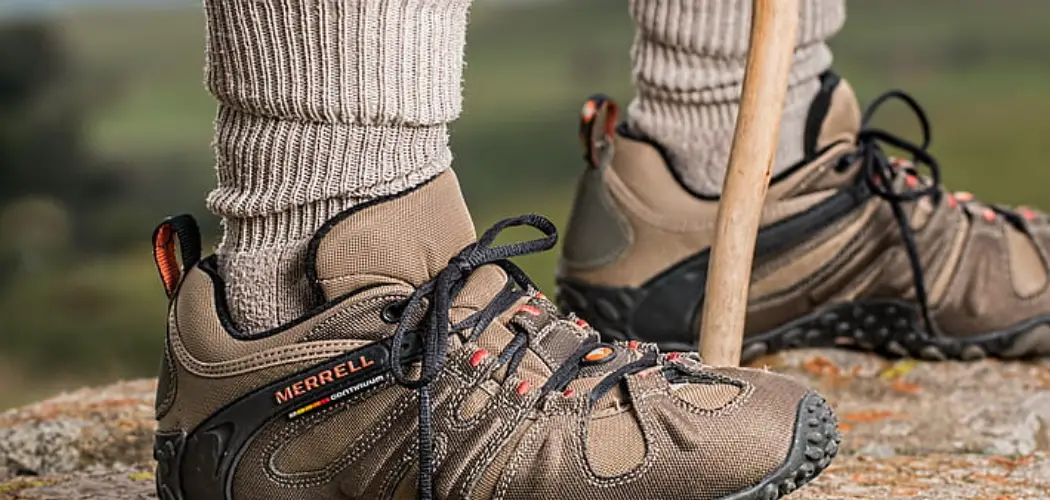The introduction to this guide begins with an essential premise: the trail beneath our feet demands respect, and one of the best ways to honor this is by selecting proper footwear. Hiking shoes serve as the fundamental link between the hiker and the diverse terrains encountered, from rocky outcrops to mud-laden paths.
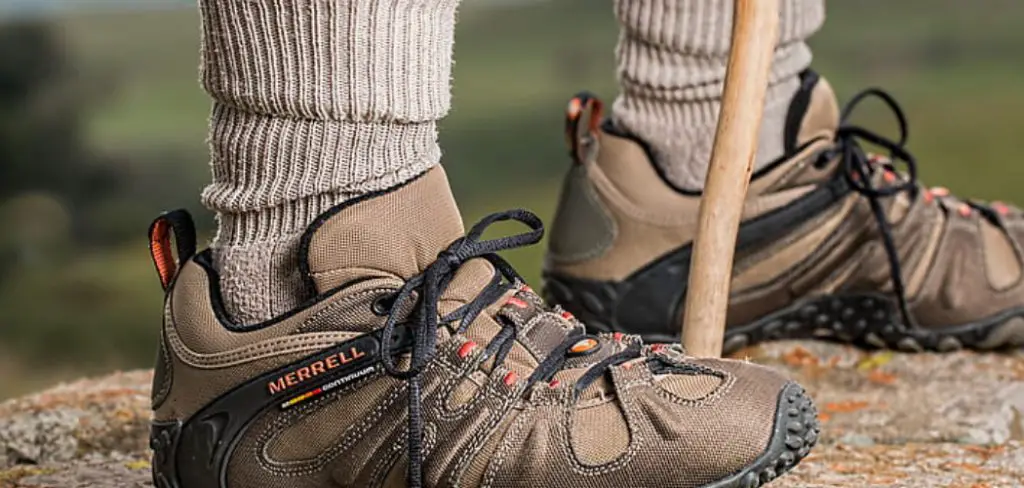
The importance of understanding how to pick hiking shoes cannot be overstated, as the right pair ensures comfort and enhances performance, allowing adventurers to focus on the beauty of their surroundings rather than the discomfort of their feet. This guide emphasizes the significance of choosing hiking shoes that offer the necessary support, stability, and protection against the unpredictable elements of the great outdoors.
Whether you’re a novice or an experienced hiker, the following step-by-step instructions are designed to guide you in selecting the ideal hiking shoes for your next adventure, ensuring your outdoor escapades are both enjoyable and safe.
Understand Your Needs
Before venturing into the world of hiking shoes, it’s crucial to understand your specific needs. This understanding forms the bedrock of your decision-making process, guiding you to a pair of shoes that are comfortable and perfectly suited to your hiking ambitions.
A. Consider Terrain and Conditions
The diversity of trails and outdoor environments is as broad as nature itself, ranging from smooth, well-trodden paths to rugged, uneven terrains. When considering how to pick hiking shoes, assess the types of trails you are most likely to explore. For gentle, flat trails, support and traction needs might be minimal.
However, shoes with enhanced support and superior traction are necessary for more challenging or slippery terrain to ensure safety and stability. Different shoes are designed to tackle specific conditions, from muddy paths to rocky inclines, so understanding the terrain will steer you toward the right choice.
B. Determine Activity Level
Your hiking frequency and the intensity of your hikes are next on the list. Choosing a versatile, comfortable shoe for shorter treks might be sufficient if you’re an occasional hiker. However, for avid hikers traversing long distances or engaging in multi-day hikes, durability, support, and comfort become paramount. The right shoes can significantly impact your performance and enjoyment, turning an arduous trek into a pleasurable adventure.
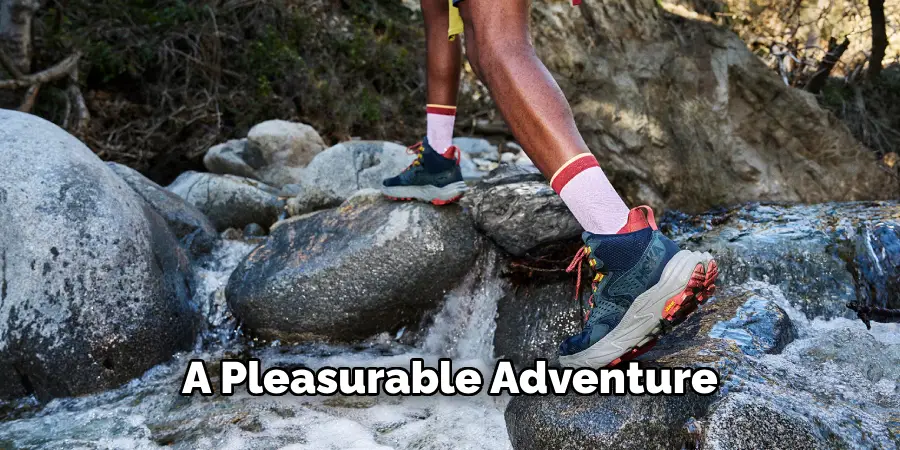
C. Know Your Feet
Every foot is unique, and knowing the specifics of your feet is essential in finding the ideal hiking shoes. Consider your foot shape, arch type, and any specific issues like flat feet, high arches, or pronation. These factors dramatically influence shoe selection, as the right fit ensures proper support, reducing the risk of discomfort or injury. For those with particular foot conditions, shoes with specialized support or the option to insert orthotics might be necessary.
How to Pick Hiking Shoes: Choose the Right Type
When it comes to how to pick hiking shoes, understanding the different types available and their intended uses is crucial. The right choice can enhance your hiking experience, providing the necessary support, protection, and stability for the terrain you plan to tackle. Here’s a breakdown of the primary types of hiking footwear:
A. Low-Cut Hiking Shoes
Low-cut hiking shoes are perfect for light hiking and trail walking on well-maintained paths. They are designed to be lightweight and flexible, offering comfort and sufficient support for day hikes or short-distance walks. These shoes typically have a breathable design, which helps in keeping your feet cool during warm-weather outings. However, they offer less protection and ankle support than mid-cut or high-cut boots, making them less suitable for rough terrain or carrying heavy backpacks.
B. Mid-Cut Hiking Boots
Mid-cut hiking boots provide a balanced option for those who venture onto more demanding trails or undertake moderate hiking. They extend over the ankle, offering increased support and protection against sprains or injuries. Mid-cut boots are more robust than low-cut shoes, equipped with sturdier soles and better traction for handling uneven or slippery surfaces. Their design also protects against trail debris and moisture, making them suitable for diverse hiking conditions.
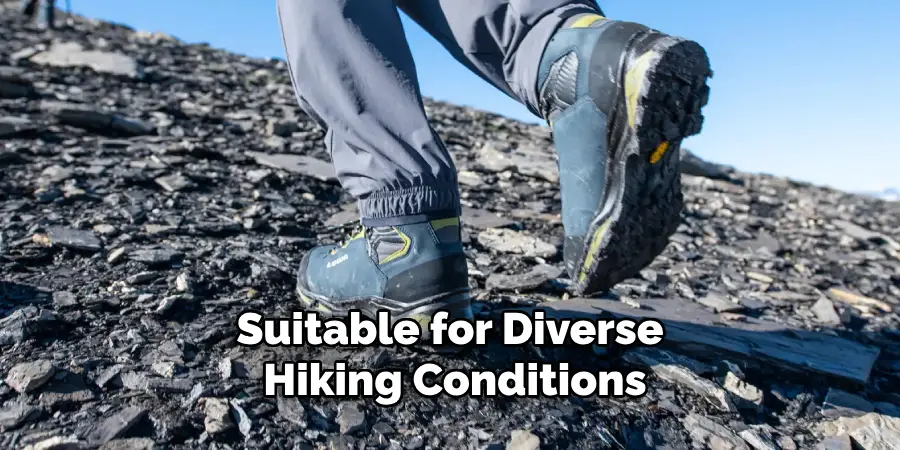
C. High-Cut Hiking Boots
High-cut hiking boots are the go-to option for intense hiking, backpacking, or mountaineering on challenging terrain. These boots are designed to offer maximum ankle support and stability, essential for navigating steep inclines, rocky paths, or carrying heavier loads.
High-cut boots focus on durability and protection and feature tough, waterproof materials and aggressive tread patterns for superior grip. Although they require a breaking-in period and are heavier, their robust construction ensures long-term performance in the most demanding outdoor adventures.
Choosing the right type of hiking footwear is a fundamental step in preparing for your outdoor excursions. Consider the nature of your hiking activities, the terrain you’ll encounter, and your personal comfort and support needs to make an informed selection that will enhance your hiking experience.
How to Pick Hiking Shoes: Consider Features
When selecting hiking shoes, evaluating their features is critical for ensuring they meet your needs and enhance your hiking experience. Here’s a detailed look at some key features to consider:

A. Materials
The material of your hiking shoes impacts their durability, comfort, and breathability. Leather offers excellent durability and resistance against wear and tear, becoming more comfortable over time as it molds to your feet. Synthetic materials, such as nylon and polyester, are lighter and often more breathable, keeping your feet cooler during hikes. Another popular option is Gore-Tex®, a waterproof and breathable fabric, ideal for hiking in wet conditions while keeping your feet dry.
B. Traction
Traction is vital for maintaining stability and safety on various terrain types. Look for shoes with high-quality outsoles, such as those made by Vibram®, known for their durability and excellent grip on both wet and dry surfaces. The depth and pattern of the lugs (the bumps on the sole) also play a crucial role; deeper lugs are better for muddy or soft ground, offering more grip.
C. Support and Cushioning
Proper support and cushioning reduce the risk of injuries and fatigue, making your hike more enjoyable. Ensure the midsole offers adequate cushioning; EVA (ethylene-vinyl acetate) is common, providing lightweight cushioning and shock absorption. Also, check for sufficient arch support and heel stabilization, which are crucial for preventing overpronation or supination and mitigating impact stress on your feet.
D. Waterproofing
Waterproofing is essential if you plan to hike in wet climates or cross water streams. Materials like Gore-Tex® keep water out while allowing vapor from sweat to escape, keeping your feet dry. However, in dry conditions, non-waterproof, breathable shoes might be preferable for better air circulation and reduced foot sweat.
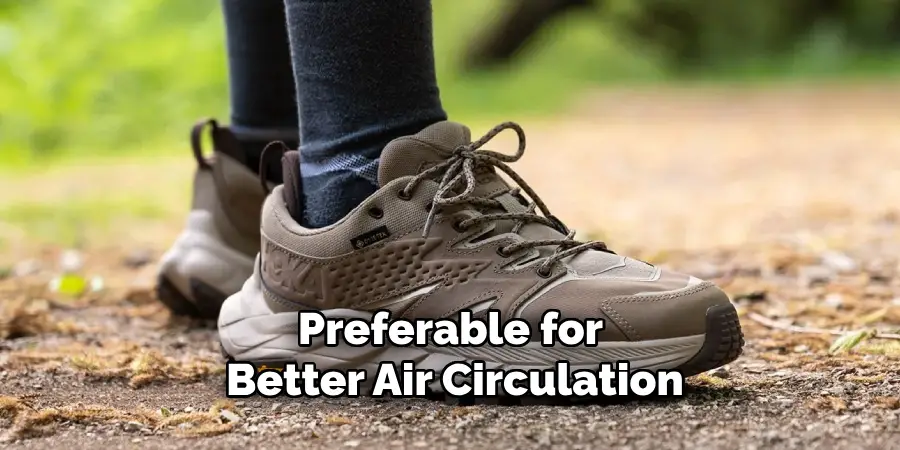
E. Weight
The weight of the shoes influences your energy expenditure during hiking; lighter shoes mean you’ll use less energy, which is ideal for fast-paced or longer-distance hikes. Conversely, heavier boots offer increased durability and protection for rough terrain or when carrying heavier backpacks. Finding the right balance based on your hiking style and terrain will ensure peak performance and enjoyment on your adventures.
Choosing hiking shoes with the right combination of materials, traction, support, waterproofing, and weight will significantly enhance your comfort and safety on the trails, making every hike an enjoyable experience.
Try Them On
Finding the perfect hiking shoes is about more than just research and knowing what features to look for. The final and perhaps most crucial step in selecting the best pair for your feet involves physically trying them on. Here’s how to ensure you get the right fit and feel:
A. Visit a Specialty Store
The best place to start is a specialty outdoor retailer with knowledgeable staff. These stores offer expert advice and assistance, guiding you through their selection of hiking shoes. The staff can provide invaluable insights into the type of shoe best suited for your activities and answer any specific questions you may have about fit, materials, and features.
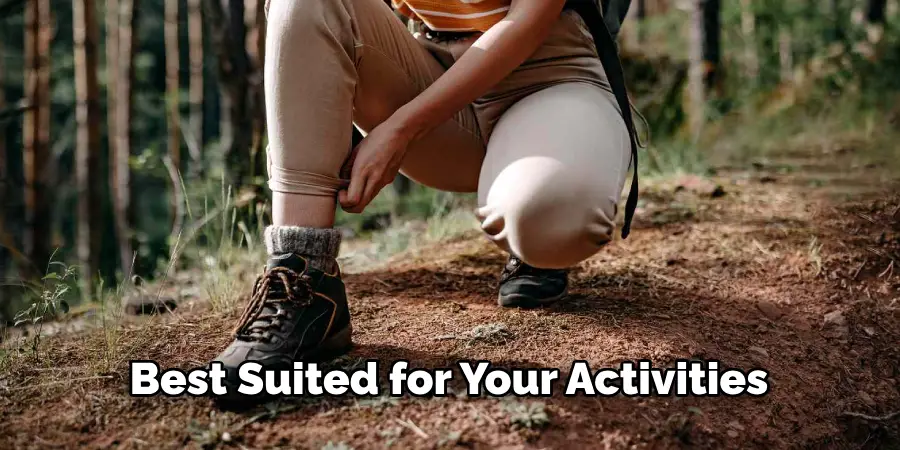
B. Wear Proper Socks
Bring along the socks you plan to wear on your hikes to get a true sense of how the shoes will feel while hiking. The thickness and material of your socks can significantly affect the shoe’s fit and comfort. This preparatory step helps ensure the shoes you choose accommodate the socks without being too tight or loose.
C. Test Fit
Take the time to try on several pairs of shoes. Walk around the store to get a feel for each pair’s comfort, fit, and support. Different brands and models can vary greatly, even if they’re the same size. Make sure to try on shoes in the afternoon or evening, as feet tend to swell throughout the day, giving you the most accurate fit for extended hiking activities.
D. Check for Fit
A properly fitting hiking shoe will have enough room in the toe box for you to wiggle your toes freely without any constriction. At the same time, ensure that your heel fits snugly and doesn’t slip or rub against the back of the shoe, as this can lead to blisters over time. An adequate fit is critical to avoid discomfort and injury on the trails.
E. Consider Orthotics
If you use orthotic inserts for additional support, don’t forget to bring them when trying on shoes. This will help you assess whether the shoes are compatible with your orthotics and if they still provide a comfortable fit and adequate support with them in place. Compatibility with orthotics can significantly impact the overall hiking experience for those who require them.
Taking these steps when trying on hiking shoes will ensure that you select a pair that offers the best fit, comfort, and support for your hiking adventures.
Make Your Decision
After carefully considering the features, trying on several pairs, and evaluating your specific needs, you’re now at the critical juncture of deciding which hiking shoes to purchase. Here’s a guide to ensure you make the best choice:
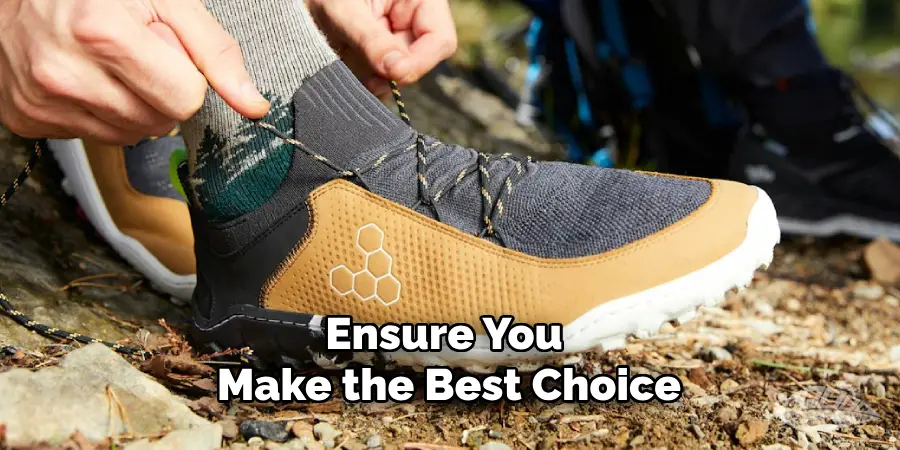
A. Assess Comfort
Prioritize comfort and fit above all else, as uncomfortable shoes can quickly turn a beautiful trail into a painful ordeal. Remember, discomfort and blisters can ruin your hike and cause long-term foot problems. Your feet should feel supported and snug, without any pinching or unnecessary space that could cause slipping or rubbing. Comfort is king on the trails, so choose shoes that feel like a natural extension of your feet.
B. Consider Price vs. Value
While budget constraints are real, investing in a high-quality pair of hiking shoes that offers the right balance of features you need can save money and discomfort in the long run. Cheaper options might be tempting, but they often come at the cost of durability, comfort, or adequate support.
Evaluate the price in relation to the value you’re getting—durability, materials, technology, and the craftsmanship behind the shoes. Sometimes, spending a bit more upfront for a pair of shoes that last longer and perform better provides greater value than buying a cheaper pair that needs replacement sooner.
C. Read Reviews
Online reviews and recommendations from the hiking community can offer invaluable insights into the real-world performance of hiking shoes. Look for reviews from people who have used the shoes in conditions similar to those you expect to encounter. Pay attention to repeated comments about durability, waterproofing effectiveness, and comfort over long distances. Recommendations from other hikers, especially those with similar foot shapes or hiking preferences, can also guide your decision.
D. Don’t Rush
Taking your time to make an informed decision is crucial. Hiking shoes are a significant investment in your hiking experience and comfort. Weigh all factors—fit, comfort, durability, waterproofing, traction, and price. Consider returning to the store to try on your top choices again or doing additional research online. The right pair of hiking shoes will feel both comfortable and confident in your choice.
Making a careful and considered decision will ensure you invest in a pair of hiking shoes that enhances your hikes, supports your feet, and withstands the challenges of the trails you choose to explore.
Care and Maintenance
Proper care and maintenance of your hiking shoes are critical to extend their lifespan and maintain their performance. Here are key steps to follow:
A. Follow Manufacturer Guidelines
Each pair of hiking shoes comes with care instructions from the manufacturer. Adhering to these guidelines is crucial for preserving the quality and performance of your shoes. These instructions typically cover cleaning methods, recommended products for maintenance, and storage advice to prevent damage when the shoes are not in use.
B. Clean Regularly
After each hike, cleaning your shoes thoroughly to remove dirt, mud, and debris is important. Use a brush or cloth to clean the surface and a mild soap for tougher stains. Allow your shoes to air dry completely in a well-ventilated area away from direct heat sources, as excessive heat can damage the materials of the shoes.
C. Inspect for Wear and Tear
Regularly inspecting your hiking shoes for signs of wear, damage, or deterioration is essential. Pay particular attention to the soles and uppers. Address any issues promptly, such as replacing worn laces or applying a waterproof treatment if the water resistance begins to fade. Early detection of problems can save you from discomfort on the trails and prevent the need for premature replacement.
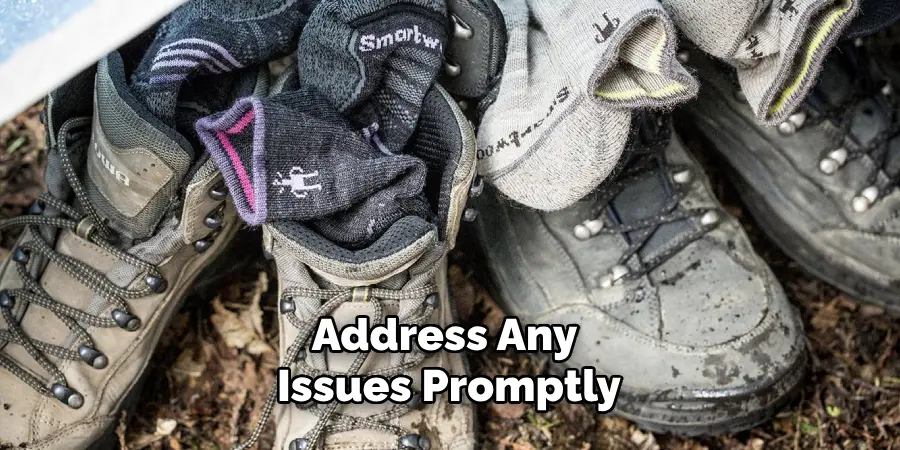
Frequently Asked Questions
Q1. How Often Should I Replace My Hiking Shoes?
A1. The lifespan of hiking shoes varies based on the quality of the shoes, the terrain you hike on, and how often you use them. On average, a good pair can last between 300 to 500 miles. Pay attention to the soles for significant wear and any discomfort or reduced support, indicating that it’s time for a replacement.
Q2. Can I Make My Hiking Shoes More Waterproof?
A2. Yes, you can enhance the water resistance of your hiking shoes by applying waterproofing treatments such as sprays or waxes designed for footwear. It’s essential to clean your shoes thoroughly before applying any treatment and to follow the product instructions for the best results. Remember, these treatments need to be reapplied periodically to maintain effectiveness.
Q3. Is It Necessary to Break in New Hiking Shoes Before a Long Hike?
A3. Absolutely. Breaking in your hiking shoes is crucial to prevent blisters and discomfort during long treks. Start by wearing your new shoes on shorter walks or around the house. Gradually increase the distance and terrain complexity over a few weeks to ensure your shoes are comfortable and fit well for longer hikes.
Conclusion
In our comprehensive guide on how to pick hiking shoes, we’ve navigated through the essential steps to ensure you find the perfect pair tailored to your needs, preferences, and budget. From understanding different types of hiking shoes to considering vital features like support, fit, and durability, we’ve underscored the importance of an informed decision-making process.
Investing time and effort into finding the right shoes is crucial, as this directly impacts your comfort, support, and overall enjoyment on any hiking adventure. Taking these steps seriously will help prevent discomfort and injuries, enabling you to explore the great outdoors with increased confidence and comfort.
Remember, the right pair of well-fitted hiking shoes can transform your hiking experience, making every trail an opportunity to discover the beauty of nature without the distraction of uncomfortable footwear. May this guide inspire you to tread confidently into your next outdoor adventure, knowing your feet are well-supported every step of the way.

